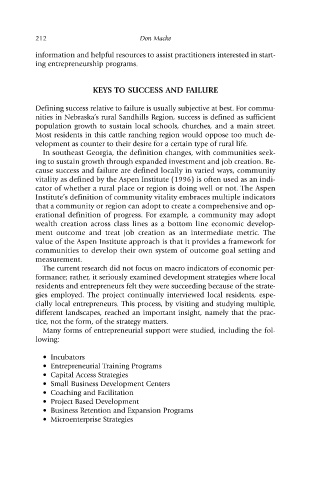Page 223 - 1-Entrepreneurship and Local Economic Development by Norman Walzer (z-lib.org)
P. 223
212 Don Macke
information and helpful resources to assist practitioners interested in start-
ing entrepreneurship programs.
KEYS TO SUCCESS AND FAILURE
Defining success relative to failure is usually subjective at best. For commu-
nities in Nebraska’s rural Sandhills Region, success is defined as sufficient
population growth to sustain local schools, churches, and a main street.
Most residents in this cattle ranching region would oppose too much de-
velopment as counter to their desire for a certain type of rural life.
In southeast Georgia, the definition changes, with communities seek-
ing to sustain growth through expanded investment and job creation. Be-
cause success and failure are defined locally in varied ways, community
vitality as defined by the Aspen Institute (1996) is often used as an indi-
cator of whether a rural place or region is doing well or not. The Aspen
Institute’s definition of community vitality embraces multiple indicators
that a community or region can adopt to create a comprehensive and op-
erational definition of progress. For example, a community may adopt
wealth creation across class lines as a bottom line economic develop-
ment outcome and treat job creation as an intermediate metric. The
value of the Aspen Institute approach is that it provides a framework for
communities to develop their own system of outcome goal setting and
measurement.
The current research did not focus on macro indicators of economic per-
formance; rather, it seriously examined development strategies where local
residents and entrepreneurs felt they were succeeding because of the strate-
gies employed. The project continually interviewed local residents, espe-
cially local entrepreneurs. This process, by visiting and studying multiple,
different landscapes, reached an important insight, namely that the prac-
tice, not the form, of the strategy matters.
Many forms of entrepreneurial support were studied, including the fol-
lowing:
• Incubators
• Entrepreneurial Training Programs
• Capital Access Strategies
• Small Business Development Centers
• Coaching and Facilitation
• Project Based Development
• Business Retention and Expansion Programs
• Microenterprise Strategies

